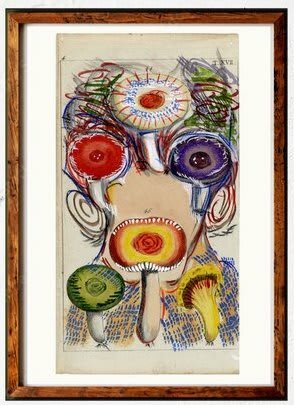
* This is our inaugural show at our second space FLXST Fracas at the Mana Contemporary Building
CURATOR STATEMENT
FLXST Contemporary opens its new gallery space FLXST601 at the Mana Contemporary building with a solo show by Alexis de Chaunac Minutiae: Works on Paper. Defined as the small or precise details of something, the works on paper in the show redefine “minutiae” as creative gestures or acts of an artist responding to the details presented on the paper medium. In de Chaunac’s case, the artist uses pages ripped from botanical and zoological books published in the 18th and 19th centuries to use as his source material from which the colorful portraits emerge. The minutiae found on the pages and the artist’s meditative process of living with the pages for an extended period before painting, drawing, or inking the pages. The historic details of plants and animals on the pages facilitate the creations of surrealistic faces, portraits of otherworldly creatures that could only come to presence because of the minutiae found on the pages. The artist’s excavation of the historic documents for his work reflects both a reverence for historical artifacts as well as an irreverence through the destruction of the pages by transforming the surfaces into portraits. de Chanauc’s fantastical portraits triumph over the staid scientific empiricism of the botanical and zoological studies found on the pages. Perhaps we should consider these works on paper as statements that art and science can coexist? Their coexistence demands viewers to think beyond the conventions of science and to stretch their imaginations to see what other bodies might be hiding between and among the lines and historic illustrations as the artist has done.
ARTIST STATEMENT
Minutiae (the small, precise, or trivial details of life). Since I was a child, I have been fascinated by the natural world, collecting insects, plants, and minerals. Coinciding with the spirit of naturalists, I feel the urge to name, label, and classify the world around me. In the series Minutiae, I paint and draw on top of original engravings from the 18th and 19th centuries, giving new life to these enigmatic naturalistic illustrations of typified fungus, lichens, viruses, and small aquatic life such as fish and octopus. As I work on top of them with brushes and pencils, I introduce subtle forms and colors that give new meaning to the source material while keeping visible the original illustration and the accurate name of each specimen. I like to combine scientific rigor through observation with a sense of fantasy and optical illusion: among the specimen, camouflaged human faces emerge. I strongly believe we have a symbiotic relationship with these extremely complex beings.
ARTIST BIOGRAPHY
Alexis de Chaunac is a Mexican-French artist born in New York City in 1991. He received a Bachelor of Arts degree from Sarah Lawrence College in 2014. He attended the University of Oxford, the UK as an exchange program and is currently an MFA candidate at the School of the Art Institute of Chicago. He is recipient of the Fundación Jumex de Arte Contemporáneo grant. His works have been exhibited in galleries and museums such as Sargent’s Daughters in New York (2019), Carrillo Gil Art Museum in Mexico City (2017), and Silas von Morisse Gallery in Brooklyn, NY (2015). He has been featured and given interviews to publications such as Whitewall, Whitehot Magazine, and Artsy’s Editorial. He currently lives and works in Chicago, IL.
De Chaunac produces rich, multilayered works filled with faces and laden with cultural references. His practice lately has included the use of silkscreens, digital prints, and collage in dialogue with the Surrealists and Neo-Dada artists. Collage has allowed him to tell several stories at the same time and to render his own lived experiences through an expansive archive of materials combining his personal memories with the collective human experience. He scratches the surface, digging a past history, an archaeology of some sort where the image underneath is revealed. His work not only looks towards the past but also towards the future, creating a space where viewers can feel more present with their own bodies in relation to the world.



